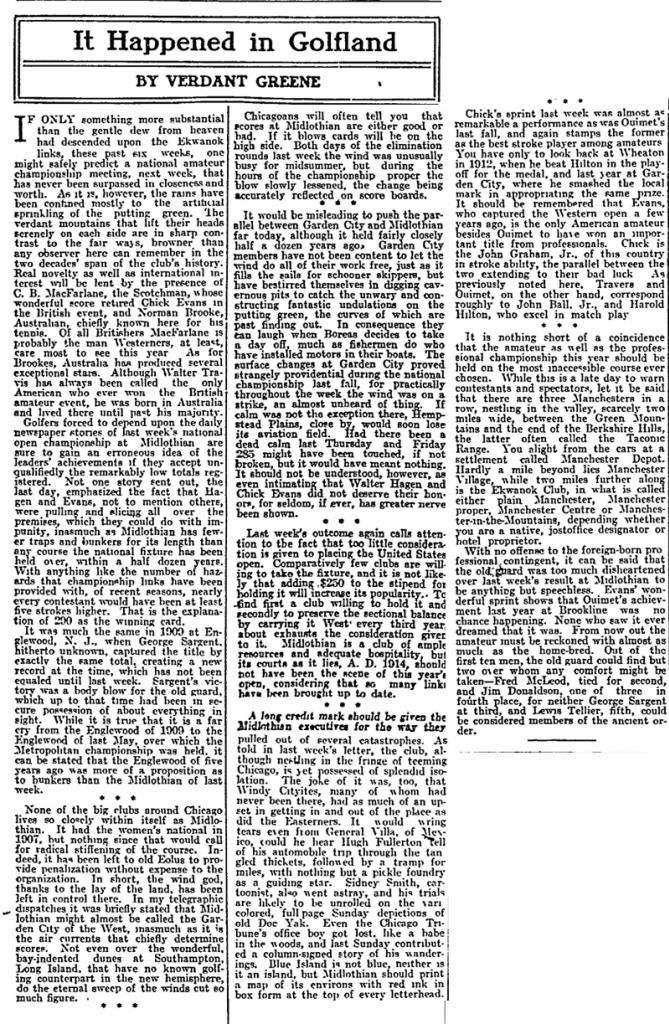Moriarty- In the past year or so I've read everything you just posted and more. The good news is I just got information from a great source regarding Donald Ross and Midlothian. He says Ross was definitely at Midlothian in the two years prior to the U.S. Open. I'll get more information when I talk with him later today or tomorrow.
Great. I hope you share your findings here. Ross was in the area during the approximate window of time, so it is possible at least. But we can't just assume it so just because we would like it to be so, just as I don't think we can assume that "best professional talent obtainable" was referring to Ross. (If we are going down that road, we might as well attach Colt the to project too.)
I don't put much stock into what Mr. Behr and Mr. Anderson wrote because I've talked to countless golf course architects that think Midlothian has some of the best bones in the country. I've also read articles and books in which prominent golfers and legendary golf course architects praise Midlothian before it became an arboretum.
I am not so sure I'd be so quick to disregard the views of Max Behr and John G. Anderson, two of the most prominent and knowledgeable golf writers of the era. Behr and Anderson had a big advantage over the "countless golf course architects" you've talked to in that they were actually there then, and presumably had a pretty good understanding of how Midlothian was viewed at the time. At the very least it might make sense to try and understand their harsh assessment in the context of what was ongoing in golf course architecture circa 1914.
Don't get me wrong. I don't mean any of this as a criticism of Midlothian, and I don't doubt that Midlothian has good bones. But
in the context of what was ongoing in golf course design circa 1914, it seems to have been considered outdated by some of the most prominent authorities of the time. Looking at the various articles it seemed the criticism focused on the ease of the course and the lack of well placed bunkers to create challenge in the age of the Haskell Ball. Many courses with "good bones" faced similar challenges. Chicago Golf Club is one such example. It too was a course with good bones, but was considered antiquated and too easy by around this time, and its bunkering scheme was updated accordingly. It was very common at the time, to the point that most if not all of the prominent golf courses across the country were altered to the point that it is hard to really understand what gca was like beforehand.
Here is another article, this one written another prominent golf writer, "Verdant Greene," in the Philadelphia Inquirer shortly after the tournament. While "Greene" perhaps wasn't as explicitly harsh as were Behr and Anderson, he certainly did not think that the course was not up to hosting even a U.S. Open, which (again) was not yet considered much of a prestige event. From the article:
Last week's outcome again calls attention to the fact that too little consideration is given to placing the United States Open. Comparatively few clubs are willing to take the fixture, and it is not like adding a $250 to the stipend for holding it will increase its popularity. To find first a club willing to hold it and secondly to preserve the sectional balance by carrying it West every third year about exhausts the consideration given to it. Midlothian is a club of ample resources and adequate hospitality, but its courts[sic] as it lies, A. D. 1914, should not have been the scene of this year's open, considering that so many links have been brought up to date. 
[Joe, did you ever figure out who Verdant Greene was? Have you considered Anderson? Off the top of my head I can think of a few "Greene" articles which might have been drawing on Anderson articles.]